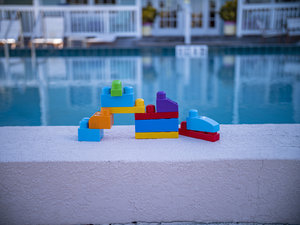One of the biggest struggles instructors face is the daunting task of filling up an entire class with appropriate exercises. Jenni Lynn Patterson-LaCour is here to help! Deck Blocks starts out with a 50-move library that includes 10 moves from different class components. The video then demonstrates selecting exercises from each component to create a class. Newer instructors will benefit greatly from the additional Online Ed Program that includes an 8-page handout and a 20-question quiz approved for 2.0 AEA CECs.
The inspiration for Deck Blocks came from Jenni Lynn’s own struggles as a new instructor and her experience helping other instructors create class content. Recently, Jenni Lynn has been mentoring some of her participants to get certified with the Aquatic Exercise Association (AEA) and teach classes. “The question I most frequently get from them is how to fill a class and make sure it is a complete and balanced workout,” says Jenni Lynn. Consequently, she began reflecting on how she taught herself to create classes. “I realized that the method I used looked almost like blocks that I had put together or stacked on top of each other.” These blocks she is referring to started with a warm up, featured a main conditioning phase and ended with a cool down. Obviously, the main conditioning phase is what new instructors struggle the most with. As stated in chapter 11 of the AEA certification manual, there are numerous options for filling up the main conditioning phase of a class. Jenni Lynn wanted to demonstrate that by using aquatic base moves and then applying variations to these moves, instructors end up with numerous options. “I wanted to show teachers who struggle with class creation that you can build from the basics and create a variety of blocks or segments in your classes that are balanced and safe for all types of participants.”
DECK BLOCKS: VIDEO-AT-A-GLANCE
The Deck Blocks video includes both a movement library that features 50 different exercises and a template for choosing moves to appropriately fill up the different “blocks” of your class. The video and class template are divided into 5 segments, a warm-up, cooldown and three different options that can be used in the main conditioning phase. The link below includes the 50-move library and room to make notes.
DOWNLOAD 50-MOVE LIBRARY

Segment 1: Warm-up
The warm-up in an aquatic fitness class serves three purposes. The first phase of the warm-up is to get the body thermally acclimated to the cooler pool temperatures. This means you have to get moving! A warm-up can also include an optional pre-stretch to prepare the muscles, joints and tendons for exercise. This pre-stretch should be dynamic so that the body stays warm. Finally, the warm-up should include a cardiorespiratory component that gradually increases heartrate. Jenni Lynn includes 10 of her go-to warm-up exercises in the video library.
Segments 2, 3 & 4: Conditioning Options
The conditioning phase of a class essentially identifies the type of format the program is. According to the Aquatic Exercise Association (AEA), these class formats will typically fall into one of five categories or a combination of them: 1) cardiorespiratory endurance training, 2) muscular conditioning, 3) muscular flexibility/ROM, 4) neuromotor exercise and 5) skill-related training. In Segment 2, Jenni Lynn focuses on muscular conditioning without equipment by choosing 10 exercises that target specific muscle groups. In Segment 3, Jenni Lynn chooses a Boot Camp block for cardiorespiratory endurance training. The 10 exercises selected for this block reflect more powerful and high intensity exercise. There are several training options/blocks you can choose from to target cardiorespiratory endurance, including HIIT, circuit, interval, choreography, dance fitness, kickboxing, water walking, equipment and more. In Segment 4, Jenni Lynn chooses 10 functional training exercises for a block that represents both neuromotor exercise and skill-related training
Segment 5: Cool-Down
The cooldown typically includes two parts, a cardiorespiratory cool down and a post-stretch. In Segment 5, Jenni Lynn chooses 10 of her favorite dynamic and static stretches.
Deck Blocks Online Education Program
The Deck Blocks Online Ed program includes an 8-page CEC handout and a 20-question quiz approved for 2.0 AEA CECs. The CEC handout expands the education behind the library and template by helping instructors understand the essential components of a typical aquatic fitness class and the types of exercises that are appropriate for those components. The expanded education is designed to build confidence and skills in creating effective and well-balanced water exercise classes. There are currently 19 Online Ed programs available on Fitmotivation.com. Most feature specialty topics and are geared towards more seasoned instructors. However, in addition to Deck Blocks, there are three other Online Ed Programs that are ideal for newer instructors.
Aqua Free
50 Ways to Change a Move
Aqua Musicology/Deck Instruction
Fitmotivation would like to thank Jenni Lynn Patterson-LaCour for coming to Florida to film 4 more videos and for once again sharing her passion and talents with subscribers. Check out other Fitmotivation videos featuring Jenni Lynn and the S’WET brand – including, Back Wall, Freestyle Flow, Noodle Rx, Super Circuit 1, Wicked Wall, S’WET Boot Camp, S’WET Deep, S’WET Challenge and Wave Warrior, and S'WET Silver. Interested in hosting or attending S'WET workshops? Visit the S'WET website or connect with them on Facebook, Instagram, Youtube and Twitter.